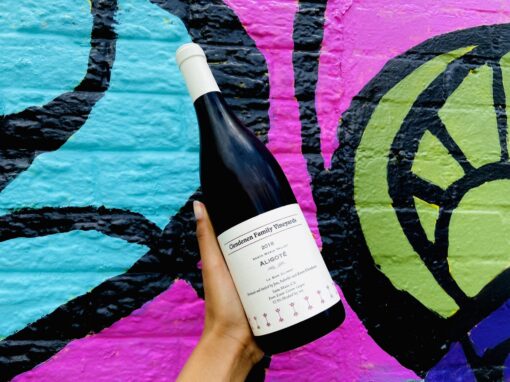Looking back, I had no clue there were thousands and thousands of grape varietals when I first started getting really into wine five years ago. Then, I thought I was doing big things by drinking a Cab or Sauvignon Blanc, but in the world of wine that wasn’t even the tip of the iceberg. Over the course of my journey, I’d learn (and I’m still learning) that there are so many unique varietals that will never make it on the shelves of a grocery store or even at a restaurant. But, wine friends, that’s what I’m here for….to do the leg work, so that you can just sit back and sip. I always geek out when I come across a new varietal and that’s why I’m starting this series called “New Grape Ish” as a way to share my findings and help you discover wines that could be the perfect match for your palate.
This week, I’m talking about the Aligoté grape. I actually tried an Aligoté wine earlier this year at this Girl Scouts cookie wine pairing event and was pretty impressed. It’s always been in the back of mind to look into it more. No time like a pandemic the present, right? Let’s take a deeper dive into this grape.
What is Aligoté?
Aligoté (pronounced “al-uh-GO-tay”) is a white grape from Burgundy, France. It’s often referred to as Burgundy’s “other” white grape—the primary being Chardonnay. I like to think of Aligoté as that younger sibling that’s always been in the shadows of their sibling (Chardonnay) and never had the opportunity to fully shine because their sibling was always in the spotlight. Aligoté doesn’t always get the respect it deserves because the grape is thin and acidic and has often only been found as the base ingredient for a popular French cocktail called Kir. But, I hope that you’ll see there is plenty of potential for drinking very good Aligoté wine.
Wines produced from Aligoté are generally dry in style, with floral and herbal notes, naturally enhanced by the variety’s high levels of acidity. It is often used in blends, particularly those made in California for the U.S. market, where it can bring much-needed acidity and aroma to richer, less-structured wines.
Food Pairings
Since there’s a lot of minerality and acidity in Aligoté, it typically tends to pair wells with fish dishes—also soup, salads, and even your gooey cow’s milk cheeses.
2018 Clendenen Family Vineyards Aligoté (Santa Maria, California)
I picked up this particular Aligoté at my local wine bar 13 Celsius in Houston. I just want to put it out there now that you’re not going to find this wine at your local grocery store. You’d probably need to check with a wine retail shop or wine bar, but even then you may not find this particular producer. But, please don’t let that stop you for going out to find a different Aligoté wine.
Anyways, this white wine has a pale-golden straw color with soft floral aromas with hints of fruit like green apple and lemon. On the palate, I found the wine to be medium in body. The flavors were all over the place. It got a little pear, hazelnut, and this slight creaminess of lemon curd. I hate to say it because I know it’s going to turn people who hate oaked Chardonnays away, but it’s a very distinct flavor that you cannot deny and actually yields to the wine’s rich texture. I personally really liked that part of the wine, but already know the ABC (Anything But Chardonnay) kids are going to raise an eyebrow at that one characteristic. But, wait there’s more. There is a slight tartness in the wine too, much like the Burgundian version of Aligoté, but this California version takes the traditional flavor profile to the next level. All the flavors mesh well together giving it lots of structure and creating something very enjoyable to sip on.
So, if it were up to me, Aligoté would be more mainstream. I hope that this post has sparked your interest to want to learn more. Let me know what you think. Have you tried Aligoté wine before? If so, feel free to share any recommendations. Until next time…glasses up!
